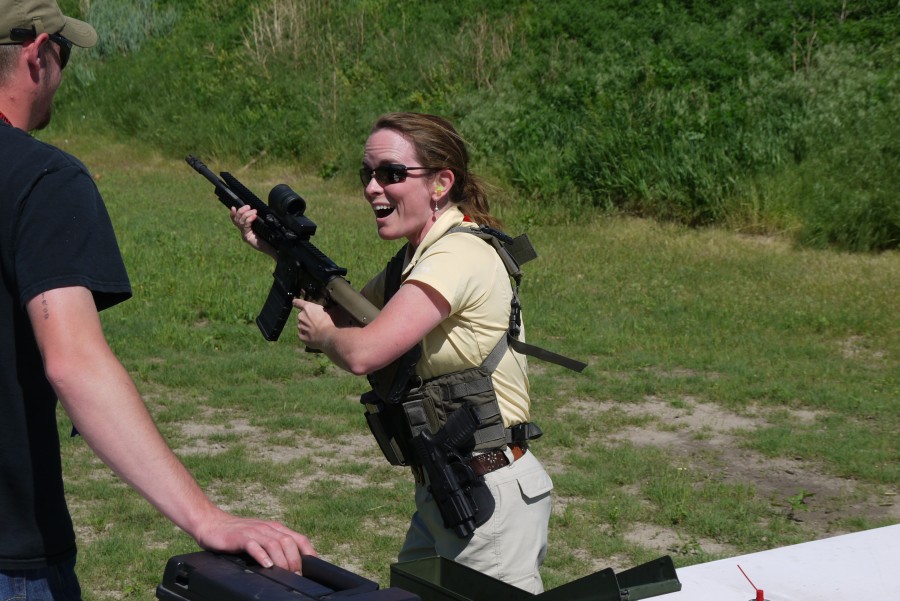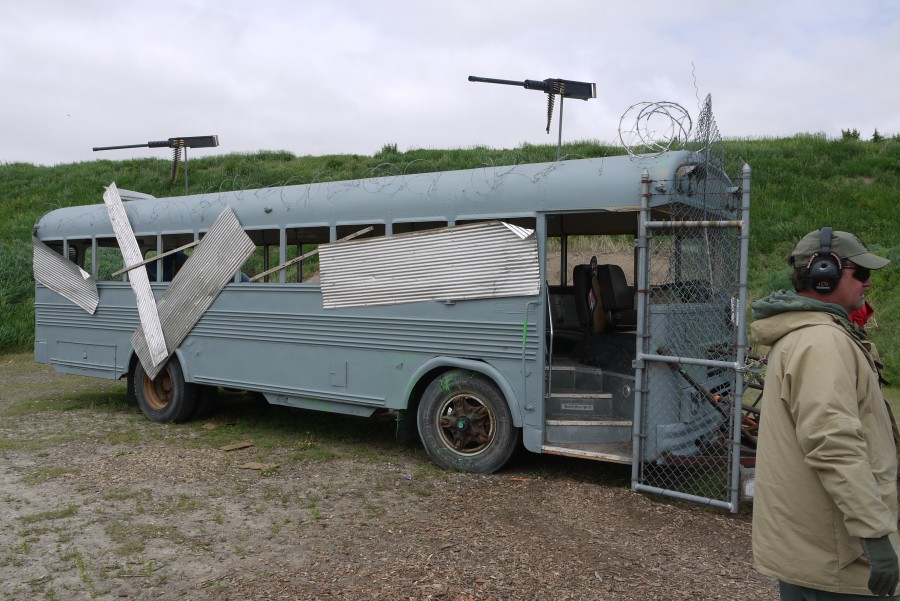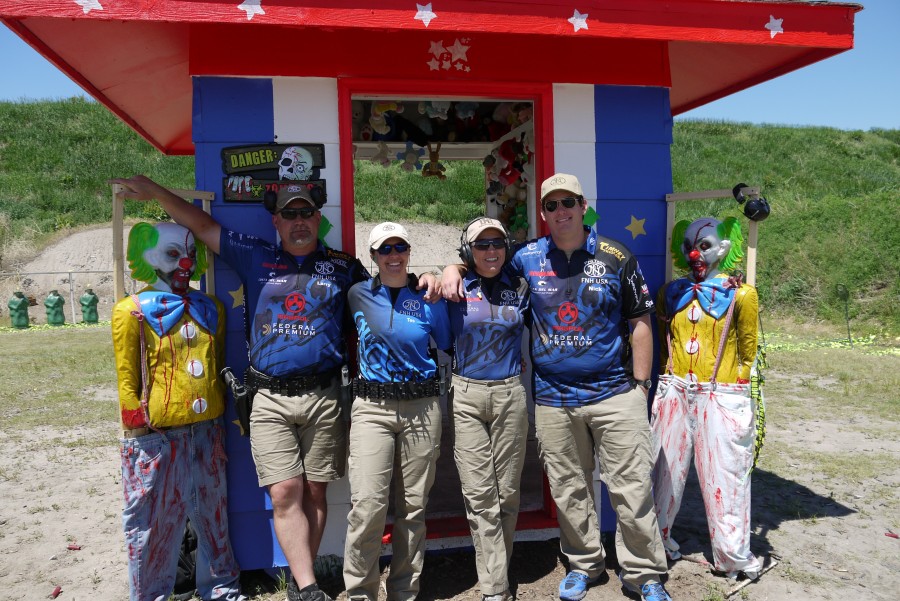The last few months have been packed full of 3-gun competitions. I knew joining Team FNH USA was going to eat up chunks of my free time this year and, sure enough, it’s absolutely dominated my weekends lately. It seems like I’ve been in a different city shooting a different match every weekend, and it’s been exhausting both physically and mentally. Thankfully, the 2013 Zombies in the Heartland match provided a weekend of fun stages where there were no gimmicks, nothing to game, and no tricks up anyone’s sleeve. That’s not to say there weren’t any teachable moments . . .
The competition consisted of fifteen stages (ten for record with five side matches) over three days, during which around 360+ shooters competed. The vast majority of those shooters were either brand new to competition shooting (as in, this was their first 3-gun match) or were less experienced (maybe 2 or 3 shoots under their belt), and the stages were designed to let those shooters enjoy the experience. A typical stage consisted of eight steel targets (for shotgun shooting), eight nifty “zombie head” clay pigeon holders (for pistol targets) and about a dozen of the paper zombie targets that hold clay pigeons in them for rifle targets all at less than 50 yards (15 yards was more typical). It’s a design that lets new shooters cut their teeth and more experienced shooters step on the gas and move quickly.
That was my goal for the competition: speed. Over the last couple months my technique had improved greatly, but I still found myself yelling at the videos afterwards to move my fat ass. I was simply shooting and moving too slowly, and I needed to pick up the pace. With the easy stage design, I figured that this was the perfect opportunity to try to get going as fast as possible and see if I could still shoot as accurately as I had been previously.
Before I move on, I want to talk about a recurring complaint I keep hearing from newer shooters. While you’d expect a national-level 3-gun event to be filled with complex stages that test your shooting skills to their limits, local matches are usually supposed to be simpler and easier. They’re intended to be stepping stones for new shooters to get some experience and have a good time, not to confuse them and send them home unhappy. That’s why I get a little annoyed when local matches start implementing design features that can only be described as 180 traps – targets set at such an angle that they will tempt the shooter to break the 180 rule and get them disqualified.
In contrast, this match had no such thing. Everything was laid out in a way that was designed specifically for safety and to keep people from getting tossed, and it paid off. I only saw two people on the final results with a “DQ” next to their name. It was a competition designed to appeal to newer shooters and I absolutely loved the concept. I know a bunch of people who are now planning to look for more local matches and keep shooting throughout the year as a result of this match.
Keeping a group that large organized and moving quickly is no small task, and if done wrong, it can lead to disaster. For example, the midnight 3-gun I had run the weekend before consisted of fewer than 50 people over six stages, but took us over 10 hours to complete. In this case, though, organization was top notch. Each squad was given a designated “wrangler” that would keep the group on task and moving along, yelling at people to reset the stage as needed and keeping track of the shooting order. It worked great and enabled us to finish the match almost exactly on schedule. It’s something that needs to be replicated at the higher level national matches, in my opinion.
Still, despite the simple stage design, there were still some issues.
Taran Butler showed up on the second day of the competition and started the day on our squad, determined to shoot the match and win. But after a minor disaster, he was knocked almost completely out of the running. There were a couple stages in which not every target was visible at the same time (you needed to peek around a barrel or some such) and Taran completely missed an entire rifle target – four clay pigeons at a price of 15 seconds each. That added a full minute to Taran’s score, and no matter how fantastic his hair looked that day, the RO wasn’t about to give him a re-shoot. So even with a simple stage design, the shooter still needs to be aware of all of his targets. Personally, I like to give the stage a quick scan after I’m finished to see if there’s anything I missed before I unload and show clear.
Another thing that caught a few shooters were the strange shotgun targets. The targets were designed specifically for the competition, cut to look like “hell hounds” (really mangy, creepy looking dogs), and the stands they were using only let them fall 45 degrees instead of all the way over. A couple shooters on our squad were caught with targets that they thought they had hit, yet were still standing thanks to that shorter fall distance. I consider that more an issue of the target’s design; targets should be clearly “down” when they’re hit, not propped halfway up, even if it does make resetting them easier. Nevertheless, if you ever run across a similar target, take the extra split second to make sure that it really is down before moving on.
I’ll save you the stage by stage breakdown, as there weren’t any tricks or choices — it was all scripted. As in, what to shoot from where and in what order. In general, the weekend was an absolute blast. The stages were simple yet fun to run, and the design included some fun elements from zombie movies of years gone by. There was the armored bus from Dawn of the Dead, a carnival booth a la Zombieland, and even “rebury cemetery” which was a fantastic play on words. I had a great time hanging out with all the guys on our squad and shooting the match, and when the final scores came out there was one last surprise waiting for me.
I had finished 21st overall and 15th in my division, but that was just icing on the cake. When I joined Team FNH USA, the image I had in my mind was how very far below their entire team I regularly scored back in Virginia, ladies included. At the level these gals compete at, they regularly blow all the guys out of the water at local matches. I was worried that I wouldn’t be able to keep pace, to compete at their level. And throughout the last couple months, I had trailed even the lady shooters in scoring. I saw a glimmer of hope when I nosed ahead of Karla at the Pro Series in Tulsa, but Sunday’s score sheets made me think that I might belong after all: I had actually beaten Dianna Liedorff by 18 seconds. Go figure.







How much would you say a weekend competition like this costs, accounting for such things as food/drinks/cheap hotel, as well as ammo? I’d love to get into 3-gun and I already have just about all the equipment, it’s the cost that gives me pause.
By the way, nice work moving up through the ranks!
Right in my back yard and I was gone for the weekend….bummer.
Looks like fun.
Remember only head shots stop zombies. I think if there were hoards of screeching zombies bum rushing you – they would have eaten your brains out by 0:11 (when you started reloading).
🙂
Head shots or a .45 ACP.
Nah. Zombies don’t have souls, so a .45 is no more effective against them than any other round.
*hordes (Unless you collect zombies in a vault or something…)
More to the point: only head shots kill zombies. Destroying knee or pelvic joints is sure as hell going to slow them down enough for you to reload.
Not that I’ve given this thought or anything. Ahem.
What if you’re hoarding them so that you can someday have a horde of your own?
Double tap people, always remember the double tap.
Did you ever shoot USPSA at soem clubs in Virginia? I kind of remember shooting a few matches with Karla before I’m wondering if I’ve run into you there too.
Nice shootings.
The Zombie War is over and they lost. Now it’s the War against Demons from the Zeta Quadrant. Get yourselves a good Chinese Broadsword, a Katana, or a Khukuri.
Nick, you know I’m a huge fan of this series, and I’ve been enjoying the hell out of your posts. But I’ve noticed a recurring theme in your recent after-action reports…
It seems like there might be a bit of sexism in your comments about shooting with the women’s squad, the results turned in by the female competitors, etc. I understand that at the very top ranks the men tend to score better than the women by a small margin, but overall the ladies (especially the pros and semi-pros) look like they hold their own.
You’re measuring yourself against a team of pros, and that’s great. I’m not sure the gender of the particular pro you managed to beat in a given match is especially relevant. Saying “I’m not at the top but at least I’m beating the girls” several different ways sends a very bad message to any would-be female 3-gunners reading your series, especially those who might look at the standings and think “just another guy-dominated sport, that doesn’t look fun”.
Even on the top level matches, are the 180 traps putting spectators in the sweep?
The DQ for 180 safety violation I hope, would only be in theory and a competition “obstacle” rather than a DQ for putting anyone in actual danger.
Which is it??
The 180 always keeps spectators out of harm’s way, but much like being a rally car photographer “out of harm’s way” is subjective.
Nevertheless, it’s such an important rule that even if no one was actually in danger breaking that 180 always needs to be a match DQ.
Good shooting Nick.
Love these videos.
I’m getting really tempted to get back into the game.
And it’s all your fault!
In a good way, of course.
Comments are closed.